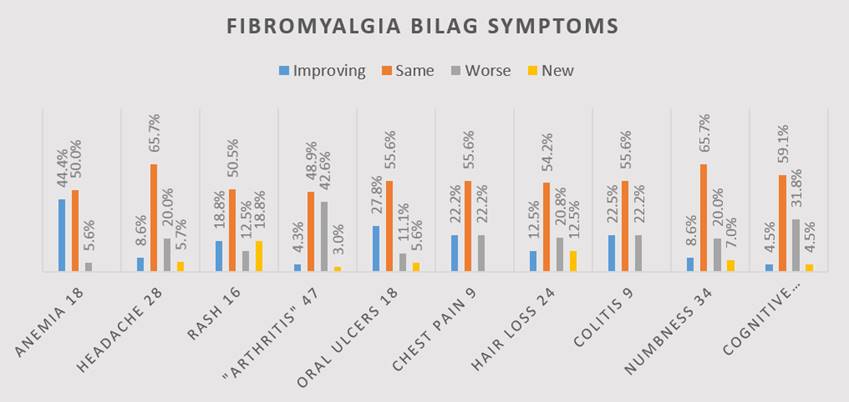Session Information
Date: Tuesday, November 7, 2017
Title: Fibromyalgia, Soft Tissue Disorders, Regional and Specific Clinical Pain Syndromes Poster II
Session Type: ACR Poster Session C
Session Time: 9:00AM-11:00AM
Background/Purpose: The BILAG is often used to assess the efficacy of lupus treatments, and is a commonly used tool in lupus drug trials. But the BILAG contains many symptoms, which are also present in fibromyalgia, and the presence of concomitant fibromyalgia in lupus patients may nullify the results of clinical drug trials. Fibromyalgia patients may not respond well to the treatment and also have more drug side effects.
Methods: Fibromyalgia patients, meeting the 2011 ACR criteria for the diagnosis, took an in-office survey listing some of the British Isles Lupus Activity Group (BILAG) lupus symptoms. The symptoms asked of fibromyalgia and non-fibromyalgia patients included anemia; mouth or nasal sources; numbness and tingling; persistent headache; chest pain; skin rash; hair loss; cognitive changes; arthritis; and colitis. They were asked to score the above symptoms using the following scale: 1, improving; 2, same; 3, worse; and 4, new.
Results: The following symptoms frequently represented by fibromyalgia patients and are among those that are part of BILAG Lupus Activity Index: Anemia, Headache, Rash, “Arthritis”, Oral Ulcers, Chest Pain, Hair Loss, Colitis, Numbness, and Cognitive
Conclusion: Many fibromyalgia patients reported that certain symptoms that are listed in the BILAG were present including mouth and oral ulcers; hair loss; numbness and tingling; cognitive changes; headaches; arthritis; and chest pain.
Concomitant lupus and fibromyalgia can nullify the results of lupus clinical drug trials and interfere with the accurate assessment of lupus. Many fibromyalgia patients report some of the symptoms listed in the BILAG, which is considered a reliable instrument for assessing lupus disease activity, but if the presence of concomitant fibromyalgia is not assessed, the results of the BILAG may be invalid. Using the 2010 ACR criteria guidelines and a simple one-page form for assessing the presence of fibromyalgia, concomitant fibromyalgia can be determined in lupus patients. This would make the BILAG a more accurate assessment tool if used for pure lupus.
To cite this abstract in AMA style:
Katz RS, Polyak JL, Leavitt F. Using the BILAG to Assess the Activity of Lupus in Patients with Fibromyalgia [abstract]. Arthritis Rheumatol. 2017; 69 (suppl 10). https://acrabstracts.org/abstract/using-the-bilag-to-assess-the-activity-of-lupus-in-patients-with-fibromyalgia/. Accessed .« Back to 2017 ACR/ARHP Annual Meeting
ACR Meeting Abstracts - https://acrabstracts.org/abstract/using-the-bilag-to-assess-the-activity-of-lupus-in-patients-with-fibromyalgia/

